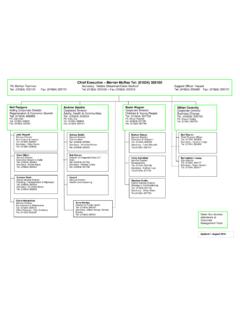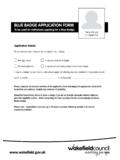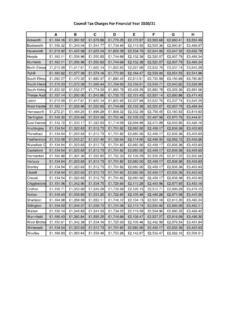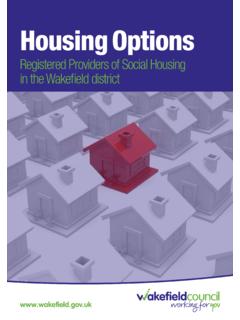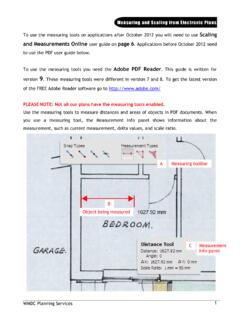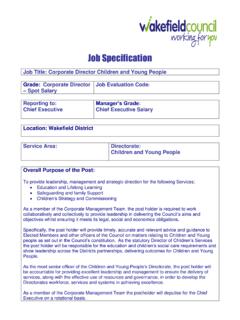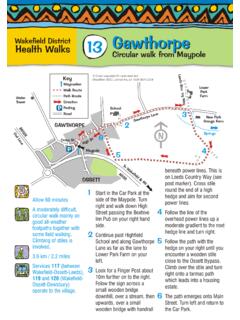Transcription of Wakefield Council Constitution 2018/19
1 1 Wakefield Council Constitution 2018/19 Approved Annual Council - 17 May 2018 Updated 10 December 201823 CONTENTSFOREWORD 5 PART 1 SUMMARY AND EXPLANATION7 THE Council S CONSTITUTION7 WHAT S IN THE CONSTITUTION7 HOW THE Council OPERATES8 THE LEADER8 JOINT ARRANGEMENTS8 OVERVIEW AND SCRUTINY9 THE Council S STAFF9 CITIZENS RIGHTS9 PART 2 ARTICLES OF THE CONSTITUTIONARTICLE 1 THE CONSTITUTION11 ARTICLE 2 MEMBERS OF THE COUNCIL13 ARTICLE 3 CITIZENS AND THE COUNCIL15 ARTICLE 4 THE FULL Council MEETING17 ARTICLE 5 ROLE AND FUNCTION OF THE MAYOR21 ARTICLE 6 OVERVIEW AND SCRUTINY COMMITTEES23 ARTICLE 7 THE CABINET (KNOWN AS THE EXECUTIVE)31 ARTICLE 8 REGULATORY AND OTHER COMMITTEES35 ARTICLE 9 THE STANDARDS COMMITTEE37 ARTICLE 10 THE LICENSING COMMITTEE39 ARTICLE 11 JOINT ARRANGEMENTS43 ARTICLE 12 OFFICERS (OTHERWISE KNOWN AS STAFF OR EMPLOYEES)45 ARTICLE 13 DECISION MAKING51 ARTICLE 14 FINANCE, CONTRACTS AND LEGAL MATTERS55 ARTICLE 15 REVIEW AND REVISION OF THE CONSTITUTION57 ARTICLE 16 SUSPENSION, INTERPRETATION AND PUBLICATION OF THE CONSTITUTION59 SCHEDULE 1.
2 DESCRIPTION OF EXECUTIVE ARRANGEMENTS61 PART 3 RESPONSIBILITY FOR FUNCTIONS63 RESPONSIBILITY FOR LOCAL CHOICE FUNCTIONS SECTION 165 RESPONSIBILITY FOR Council FUNCTIONS (NON EXECUTIVE)68 DELEGATIONS TO OFFICERS (EXECUTIVE FUNCTIONS)76 RESPONSIBILITY FOR EXECUTIVE FUNCTIONS (MEMBERS)77 EXECUTIVE LEADER AND CABINET MEMBER PORTFOLIO S80 DELEGATION OF EXECUTIVE FUNCTIONS TO CABINET MEMBERS91 JOINT ARRANGEMENTS93 OFFICER DELEGATION SCHEME FOR EXECUTIVE FUNCTIONS974 PART 4 RULES OF PROCEDURECOUNCIL PROCEDURE RULES 99 ACCESS TO information PROCEDURE RULES119 BUDGET AND POLICY FRAMEWORK PROCEDURE RULES129 CABINET PROCEDURE RULES135 OVERVIEW AND SCRUTINY PROCEDURE RULES141 AUDIT COMMITTEE TERMS OF REFERENCE159 CORPORATE PARENTING COMMITTEE161 JOINT CONSULTATIVE COMMITTEE165 LICENSING COMMITTEE AND LICENSING SUB-COMMITTEES 1 & 2169 PLANNING AND HIGHWAYS COMMITTEE173 STANDARDS COMMITTEE177 STANDARDS SUB-COMMITTEE178 HEALTH AND WELLBEING BOARD179 FINANCIAL PROCEDURE RULES191 CONTRACT PROCEDURE RULES217 SENIOR OFFICER EMPLOYMENT PROCEDURE RULES253 PART 5 CODES OF
3 PRACTICE, PROTOCOLS AND PROCEDURESMEMBERS CODE OF CONDUCT261 PLANNING CODE OF CONDUCT267 EMPLOYEES CODE OF CONDUCT279 PROTOCOL FOR EMPLOYEES ON GIFTS AND HOSPITALITY295 REGISTER OF EMPLOYEES INTERESTS305 PROTOCOL FOR COUNCILLORS WITH SPECIAL RESPONSIBILITIES AND SENIOR OFFICERS 313 SUMMARY OF THE ROLES OF THE LEADER, DEPUTY LEADER, CABINET MEMBERS, CHIEF EXECUTIVE AND CORPORATE DIRECTORS320 PROTOCOL FOR VISITS BY HM GOVERNMENT MINISTERS AND SHADOW MINISTERS TO WAKEFIELD323 PART 6 MEMBERS ALLOWANCES & OTHER RELATED EXPENDITUREMEMBERS ALLOWANCES SCHEME325 SCHEDULE 1 MEMBERS ALLOWANCES SCHEME334 SCHEDULE 2 MEMBERS ALLOWANCES RATES340 SCHEDULE 3 - CHILDCARE AND DEPENDANTS CARERS ALLOWANCES342 MAYORAL ALLOWANCES343 PART 7 MANAGEMENT STRUCTURE345 MANAGEMENT STRUCTURE CHART3465 ForewordThe Council is made up of sixty-three Councillors.
4 There are elections in three years out of four. Each of the twenty-one Wards has three Councillors and there is an election for one of these positions in each of the three election represent their constituents' interests and work to serve the District as a whole. They will sit on various Committees and Sub-Committees within the Council , and some will represent the Council and the Authority on important Outside Bodies at local, regional and national full Council is responsible for setting the overall policy framework and the budget. It meets at the County Hall in Wakefield , and its meetings are open to the public. You are welcome to Council appoints a Leader who then appoints a Cabinet, which comprises between two and nine Councillors with the Leader acting as Chair.
5 Again, the meetings are open to the public and you are welcome to attend. A Forward Plan of key decisions that will be taken is published. The Cabinet is given authority by the full Council to implement its policies within the budget and policy framework agreed by full Council . The Leader has considerable freedom to make important decisions about how services are delivered and to monitor the Council 's overall performance. Each year the Leader and Cabinet will propose a budget for the full Council to consider. This is agreed in March each year and informs the billing process for the Council Overview and Scrutiny Management Board and the three Overview and Scrutiny Committees are charged with the task of critically and objectively examining aspects of how the Council is operating.
6 They produce annual work plans and have the ability to take evidence from a range of witnesses, including community groups and national experts. They scrutinise Cabinet decisions and examine performance both of Council services and those of outside organisations with which the Council works to provide joint services. The Committees do not have decision-making powers but they have the authority to 'call in' decisions taken by the Cabinet if they believe that further consideration on that decision is Standing Committees cover Adult Services, Public Health and the NHS; Children, Young People and Skills and Economic and Environmental Wellbeing. They can call upon Councillors, Officers, and outside experts to provide evidence to inform any recommendations they wish to make.
7 The Cabinet is obliged to consider recommendations of Overview and Scrutiny Committees. If there is a failure to agree on an issue it can, ultimately, be referred to the full Council for a final and Scrutiny Committees also examine existing policy and practice with a view to seeking to identify areas for improvement. Again, their recommendations will be considered by the to day implementation of policy is undertaken by the Council staff. The management structure is shown in Part 7 of the are certain decisions about planning, licensing and regulatory matters which are not the responsibility of the Cabinet nor Overview and Scrutiny Committees. These matters are dealt with by Committees appointed by the full Council . In addition there is a Children s Committee which alongside a Standards Committee which oversees the probity of the Council 's operation, and the Code of Conduct which the Councillors have agreed to follow to ensure high standards in the way they undertake their 1 - Summary and ExplanationThe Council s ConstitutionThe City of Wakefield Metropolitan District Council has agreed a Constitution which sets out how the Council operates, how decisions are made and the procedures which are followed to ensure that these are efficient, transparent and accountable to local people.
8 Some of these processes are required by the law, while others are a matter for the Council to Constitution is divided into 16 Articles , which set out the basic rules governing the Council s business. More detailed procedures and codes of practice are provided in separate rules and protocols at the end of the s in the Constitution ?Article 1 of the Constitution commits the Council to a system of efficient, transparent and accountable governance. In carrying out its duties and responsibilities, the Council will act in an open and inclusive manner. Articles 2 to 16 explain the rights of citizens and how the key parts of the Council operate. These are: Members of the Council (Article 2) Citizens and the Council (Article 3) The Full Council Meeting (Article 4) Role and Function of the Mayor (Article 5) Overview and Scrutiny of decisions (Article 6) The Executive (Cabinet) (Article 7) Regulatory and other Committees (Article 8) The Standards Committee (Article 9) The Licensing Committee (Article10) Joint arrangements (Article 11).
9 Officers (Article 12). Decision making (Article 13). Finance, contracts and legal matters (Article 14). Review and revision of the Constitution (Article 15). Suspension, interpretation and publication of the Constitution (Article 16).8 How the Council OperatesThe Council is composed of 63 Councillors with one-third elected three years in four. Councillors are democratically accountable to residents of their ward, within the Wakefield District there are 21 wards. The overriding duty of Councillors is to the whole community, but they have a special duty to their constituents, including those who did not vote for have to agree to follow a code of conduct to ensure high standards in the way they undertake their duties. The Standards Committee ensures that training and advice on the code of conduct is Councillors meet together as the Council .
10 Meetings of the Council are normally open to the public. Here Councillors decide the Council s overall policies and set the budget each year. The Council appoints the Leader of the LeaderThe Leader holds all executive powers and may choose to also have a Cabinet to assist him/her. A Cabinet must consist of at least two but not more than nine Councillors. The role of the Leader is to provide effective strategic leadership to the authority and to ensure that the authority successfully discharges its overall responsibilities for the activities of the organisation as a whole. When major decisions are to be discussed or made, these are published in the Leader s Forward Plan of key decisions in so far as they have been anticipated. If these major decisions are to be discussed and executive decisions made, the meeting of the Cabinet, will generally be open for the public to attend except where exempt or confidential matters are being discussed.

